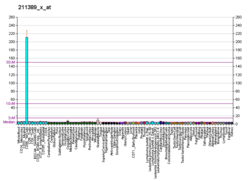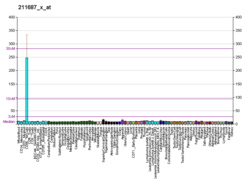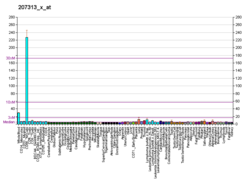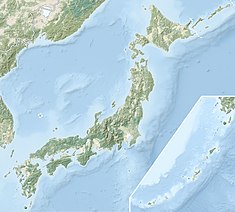KIR3DL1
KIR3DL1킬러 세포 면역글로불린 유사 수용체 3DL1은 인간 내 KIR3DL1 유전자에 의해 암호화된 단백질이다.[3][4][5]
킬러 세포 면역글로불린 유사 수용체(KIRs)는 자연 킬러 세포와 T 세포의 서브셋에 의해 발현되는 트랜섬브레인 당단백질이다.KIR 유전자는 다형성 및 고동맥성으로 1Mb 백혈구 면역글로불린 유사 수용체 복합체(LRC) 내 19q13.4 염색체의 성단에서 발견된다.여러 "프레임워크" 유전자가 모든 하플라타입(KIR3DL3, KIR3DP1, KIR3DL4, KIR3DL2)에서 발견되기는 하지만 KIR 유전자 군집의 유전자 함량은 하플라타입에 따라 다르다.KIR 단백질은 세포외 면역글로불린 영역 수(2D 또는 3D)와 세포질 영역이 긴지 짧은지(S)로 분류된다.면역 티로신 기반 억제 모티브(ITIM)를 통해 리간드 결합 시 긴 세포질 영역 변환 억제 신호를 가진 KIR 단백질은 ITIM 모티브가 부족한 반면, 짧은 세포질 영역을 가진 KIR 단백질은 대신 TYRO 단백질 티로신 키나제 결합 단백질과 결합하여 변환 활성 신호를 만든다.몇몇 KIR 단백질의 리간드는 HLA 등급 I 분자의 하위 집합이므로, KIR 단백질은 면역 반응의 조절에 중요한 역할을 한다고 생각된다.[5]
참고 항목
참조
- ^ a b c ENSG00000274146, ENSG00000278368, ENSG00000273775, ENSG00000276501, ENSG00000278427, ENSG00000274948, ENSG00000274036, ENSG00000274920, ENSG00000275786, ENSG00000276329, ENSG00000277272, ENSG00000283954, ENSG00000275486, ENSG00000275545, ENSG00000278079, ENSG00000273518, ENSG00000275717, ENSG00000277175, ENSG00000167633, ENSG00000283729, ENSG00000283731, ENSG00000276423, ENSG00000275659, ENSG00000278856, ENSG00000284426, ENSG00000275288, ENSG00000284093, ENSG00000283827, ENSG00000284177, ENSG00000276379, ENSG00000284342 GRCh38: Ensembl release 89: ENSG00000284589, ENSG00000274146, ENSG00000278368, ENSG00000273775, ENSG00000276501, ENSG00000278427, ENSG00000274948, ENSG00000274036, ENSG00000274920, ENSG00000275786, ENSG00000276329, ENSG00000277272, ENSG00000283954, ENSG00000275486, ENSG00000275545, ENSG00000278079, ENSG00000273518, ENSG00000275717, ENSG00000277175, ENSG00000167633, ENSG00000283729, ENSG00000283731, ENSG00000276423, ENSG00000275659, ENSG00000278856, ENSG00000284426, ENSG00000275288, ENSG00000284093, ENSG00000283827, ENSG00000284177, ENSG00000276379, ENSG00000284342 - 앙상블, 2017년 5월
- ^ "Human PubMed Reference:". National Center for Biotechnology Information, U.S. National Library of Medicine.
- ^ Colonna M, Samaridis J (May 1995). "Cloning of immunoglobulin-superfamily members associated with HLA-C and HLA-B recognition by human natural killer cells". Science. 268 (5209): 405–8. Bibcode:1995Sci...268..405C. doi:10.1126/science.7716543. PMID 7716543.
- ^ Wagtmann N, Biassoni R, Cantoni C, Verdiani S, Malnati MS, Vitale M, Bottino C, Moretta L, Moretta A, Long EO (Jun 1995). "Molecular clones of the p58 NK cell receptor reveal immunoglobulin-related molecules with diversity in both the extra- and intracellular domains". Immunity. 2 (5): 439–49. doi:10.1016/1074-7613(95)90025-X. PMID 7749980.
- ^ a b "Entrez Gene: KIR3DL1 killer cell immunoglobulin-like receptor, three domains, long cytoplasmic tail, 1".
추가 읽기
- Selvakumar A, Steffens U, Dupont B (1997). "Polymorphism and domain variability of human killer cell inhibitory receptors". Immunol. Rev. 155 (1): 183–96. doi:10.1111/j.1600-065X.1997.tb00951.x. PMID 9059894. S2CID 7040904.
- D'Andrea A, Chang C, Franz-Bacon K, et al. (1995). "Molecular cloning of NKB1. A natural killer cell receptor for HLA-B allotypes". J. Immunol. 155 (5): 2306–10. PMID 7650366.
- Litwin V, Gumperz J, Parham P, et al. (1994). "NKB1: a natural killer cell receptor involved in the recognition of polymorphic HLA-B molecules". J. Exp. Med. 180 (2): 537–43. doi:10.1084/jem.180.2.537. PMC 2191610. PMID 8046332.
- Döhring C, Samaridis J, Colonna M (1996). "Alternatively spliced forms of human killer inhibitory receptors". Immunogenetics. 44 (3): 227–30. doi:10.1007/BF02602590. PMID 8662091. S2CID 38478576.
- Pende D, Biassoni R, Cantoni C, et al. (1996). "The natural killer cell receptor specific for HLA-A allotypes: a novel member of the p58/p70 family of inhibitory receptors that is characterized by three immunoglobulin-like domains and is expressed as a 140-kD disulphide-linked dimer". J. Exp. Med. 184 (2): 505–18. doi:10.1084/jem.184.2.505. PMC 2192700. PMID 8760804.
- Wagtmann N, Rajagopalan S, Winter CC, et al. (1996). "Killer cell inhibitory receptors specific for HLA-C and HLA-B identified by direct binding and by functional transfer". Immunity. 3 (6): 801–9. doi:10.1016/1074-7613(95)90069-1. PMID 8777725.
- Valiante NM, Uhrberg M, Shilling HG, et al. (1998). "Functionally and structurally distinct NK cell receptor repertoires in the peripheral blood of two human donors". Immunity. 7 (6): 739–51. doi:10.1016/S1074-7613(00)80393-3. PMID 9430220.
- Uhrberg M, Valiante NM, Shum BP, et al. (1998). "Human diversity in killer cell inhibitory receptor genes". Immunity. 7 (6): 753–63. doi:10.1016/S1074-7613(00)80394-5. PMID 9430221.
- Vyas Y, Selvakumar A, Steffens U, Dupont B (1999). "Multiple transcripts of the killer cell immunoglobulin-like receptor family, KIR3DL1 (NKB1), are expressed by natural killer cells of a single individual". Tissue Antigens. 52 (6): 510–9. doi:10.1111/j.1399-0039.1998.tb03081.x. PMID 9894849.
- Kwon D, Chwae YJ, Choi IH, et al. (2000). "Diversity of the p70 killer cell inhibitory receptor (KIR3DL) family members in a single individual". Mol. Cells. 10 (1): 54–60. doi:10.1007/s10059-000-0054-0. PMID 10774747. S2CID 21075797.
- Crum KA, Logue SE, Curran MD, Middleton D (2001). "Development of a PCR-SSOP approach capable of defining the natural killer cell inhibitory receptor (KIR) gene sequence repertoires". Tissue Antigens. 56 (4): 313–26. doi:10.1034/j.1399-0039.2000.560403.x. PMID 11098931.
- Gardiner CM, Guethlein LA, Shilling HG, et al. (2001). "Different NK cell surface phenotypes defined by the DX9 antibody are due to KIR3DL1 gene polymorphism". J. Immunol. 166 (5): 2992–3001. doi:10.4049/jimmunol.166.5.2992. PMID 11207248.
- Yamochi T, Semba K, Tsuji K, et al. (2002). "ik3-1/Cables is a substrate for cyclin-dependent kinase 3 (cdk 3)". Eur. J. Biochem. 268 (23): 6076–82. doi:10.1046/j.0014-2956.2001.02555.x. PMID 11733001.
- Shilling HG, Guethlein LA, Cheng NW, et al. (2002). "Allelic polymorphism synergizes with variable gene content to individualize human KIR genotype". J. Immunol. 168 (5): 2307–15. doi:10.4049/jimmunol.168.5.2307. PMID 11859120.
- Martin MP, Gao X, Lee JH, et al. (2002). "Epistatic interaction between KIR3DS1 and HLA-B delays the progression to AIDS". Nat. Genet. 31 (4): 429–34. doi:10.1038/ng934. PMID 12134147. S2CID 6805903.
- Chwae YJ, Chang MJ, Park SM, et al. (2002). "Molecular mechanism of the activation-induced cell death inhibition mediated by a p70 inhibitory killer cell Ig-like receptor in Jurkat T cells". J. Immunol. 169 (7): 3726–35. doi:10.4049/jimmunol.169.7.3726. PMID 12244166.
- Strausberg RL, Feingold EA, Grouse LH, et al. (2003). "Generation and initial analysis of more than 15,000 full-length human and mouse cDNA sequences". Proc. Natl. Acad. Sci. U.S.A. 99 (26): 16899–903. doi:10.1073/pnas.242603899. PMC 139241. PMID 12477932.
이 기사는 공공영역에 있는 미국 국립 의학 도서관의 텍스트를 통합하고 있다.







